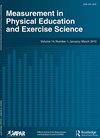婴儿俯卧时间问卷和时间使用日记对geneactive加速度计的有效性
IF 1.9
4区 教育学
Q2 EDUCATION & EDUCATIONAL RESEARCH
Measurement in Physical Education and Exercise Science
Pub Date : 2021-06-20
DOI:10.1080/1091367X.2021.1941033
引用次数: 3
摘要
本研究考察了俯卧时间问卷和时间使用日记对加速度计测量的并发效度。参与者是加拿大埃德蒙顿的29对父母和他们6个月大的婴儿。同时使用父母问卷、时间使用日记和经过验证的geneactive加速计来测量俯卧时间。在具有所有测量数据的参与者中(n = 26),对相对(Spearman秩相关)和绝对(Wilcoxon符号秩检验和Bland-Altman图)并发效度进行检验。问卷调查(rs = 0.60)和时间使用日记(rs = 0.80)的俯卧时间测量值与加速度计测量值显著相关,且效应量较大(r = 0.50)。与俯卧时间的加速度计测量相比,问卷测量的平均排名有显著差异,但时间使用日记测量的平均排名没有显著差异。Bland-Altman图显示加速度计和问卷测量之间的俯卧时间平均差异显著(42分钟/天;95%的一致性限制:−73,157分钟/天),但加速度计和时间使用日记测量(2分钟/天;95%一致性限:−47.51 min/d)。这些初步研究结果表明,这两种主观测量方法可能适用于婴儿研究,检查俯卧时间与样本之间的联系和/或比较俯卧时间。时间使用日记也可以在流行研究中提供相对精确的俯卧时间估计。本文章由计算机程序翻译,如有差异,请以英文原文为准。
Validity of an Infant Tummy Time Questionnaire and Time-use Diary against the GENEActiv Accelerometer
ABSTRACT This study examined the concurrent validity of a tummy time questionnaire and time-use diary against an accelerometer measure. Participants were 29 parents and their 6-month-old infants from the Early Movers project in Edmonton, Canada. Tummy time was concurrently measured using a parental questionnaire, a time-use diary, and a validated GENEActiv accelerometer. In participants with data on all measures (n = 26), relative (Spearman’s rank correlations) and absolute (Wilcoxon signed-rank tests and Bland–Altman plots) concurrent validity were examined. The questionnaire (rs = 0.60) and time-use diary (rs = 0.80) tummy time measures were significantly correlated with the accelerometer measure, with large effect sizes (r > 0.50). Compared to the accelerometer measure of tummy time, a significant difference in mean rank was observed for the questionnaire measure but not for the time-use diary measure. Bland–Altman plots showed a significant mean difference in tummy time between the accelerometer and questionnaire measures (42 min/d; 95% limits of agreement: −73,157 min/d) but not between the accelerometer and time-use diary measures (2 min/d; 95% limits of agreement: −47,51 min/d). These preliminary findings indicate both subjective measures may be appropriate for infant studies examining associations with tummy time and/or comparing tummy time between samples. The time-use diary may also provide a relatively precise estimate of tummy time in prevalence studies.
求助全文
通过发布文献求助,成功后即可免费获取论文全文。
去求助
来源期刊

Measurement in Physical Education and Exercise Science
Medicine-Orthopedics and Sports Medicine
CiteScore
4.20
自引率
33.30%
发文量
24
期刊介绍:
The scope of Measurement in Physical Education and Exercise Science (MPEES) covers original measurement research, special issues, and tutorials within six substantive disciplines of physical education and exercise science. Six of the seven sections of MPEES define the substantive disciplines within the purview of the original research to be published in the journal: Exercise Science, Physical Activity, Physical Education Pedagogy, Psychology, Research Methodology and Statistics, and Sport Management and Administration. The seventh section of MPEES, Tutorial and Teacher’s Toolbox, serves to provide an outlet for review and/or didactic manuscripts to be published in the journal. Special issues provide an avenue for a coherent set of manuscripts (e.g., four to five) to collectively focus in-depth on an important and timely measurement-related issue within the scope of MPEES. The primary aim of MPEES is to publish high-impact manuscripts, most of which will focus on original research, that fit within the scope of the journal.
 求助内容:
求助内容: 应助结果提醒方式:
应助结果提醒方式:


